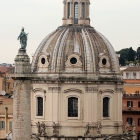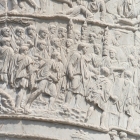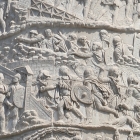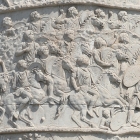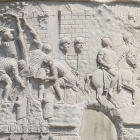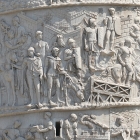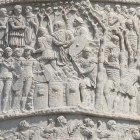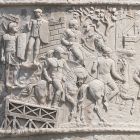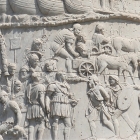How Roman emperor Trajan conquered the Dacians, reconted by the column of Apollodorus of Damascus
The conquest of Dacia by the Romans was such an important event for the empire, that Trajan payed for a nonstop party of 123 days at the Colosseum. Following the Latin motto “bread and circus”, the show was on a grandiose scale: 10.000 gladiators fought 11.000 wild animals during it. To put it in today’s terms, we’d have to imagine a war after which the US government would pay for 4 months in a row of concerts with bands like the Rolling Stones or Bon Jovi.
The gold reserves found in Dacia are probably an explanation for this outpouring of public celebrations. The gold as well as the gladiators games are long gone, but we still have a tangible proof of Trajan’s victory: the column in Rome. Found very close to the excavated Roman Forum and not far from the still standing Colosseum, the column is the biggest monument celebrating a victory in the Antique world.
Few people realize that the column is wide enough to allow visitors inside, by a spiraling staircase that climbs all the way to the top. Tiny windows are carved for light and ventilation, so skillfully that they can be hardly spotted among the sculptures. The images sculpted on the outside are probably one of the main purpose of this propagandistic monument.
In order to conquer Dacia, the Roman Empire carried out two campaigns. The first one, in 101-102 AD brought the legions over the Danube, but the fortified mountain fortresses of the Dacians were still unaccessible to them. The Romans were not hasty to expand the empire, so they built fine roads and forts (castrum), the most important being at Sarmizegetusa Regia. The Dacians, who had gathered several other enemy nations against the Romans, were forced to sign a disadvantageous peace treaty.
In preparation of the second war against Dacia, emperor Trajan, the adopted son of emperor Nerva, asked Apollodorus of Damascus to build the largest bridge ever attempted in Antiquity. The bridge over Danube was completed in two years as an amazing piece of engineering. Three centuries after, the Romans themselves dismantled it during their retreat, to prevent the barbarians from pouring in. The army used to invade Dacia was one of the largest ever employed by the empire. One third of its total army (10 legions out of 30) teamed up with mercenaries from allied nations in a military force that was over a hundred thousand men.
The brave king of Dacia, Decebalus, lost the war and committed suicide not to fall in the hands of the Romans. On the column, he is presented cutting his throat with a dagger. At institutional level, the Romans stayed in Dacia a little over a century and a half, but the territory was greatly colonized. The settlers were not necessarily from the Italian peninsula, as the chronicles describe them as coming from all the corners of the Empire. The Latin formula “ex toto orbe romano” might well mean people from the Arabic Peninsula or even the North of Africa, but the settlers were definitely bearers of the Roman civilization and language. A gold rush might explain the flow of Roman population at the North of Danube, in former Dacia, together with a deliberate colonization policy carried out by the Empire.
However the cause, the results were very lasting: from the combination of Roman settlers and local Dacians, the Romanian people was formed, which, despite numerous influences from migrating people, Slavs, Turks and others, to this days speaks a language that is strikingly close to Latin and is the only population to call itself after the Romans. In comparison, the Britain was occupied well over three centuries by the Roman Empire, yet popular English owes little to Latin language.
The heritage of the Romans in today Romania continued to grow after the retreat in 271 AD, by the spread of Christianity. After Diocletian split the Empire and Constantine moved the Capital to Constantinople (Istanbul), the former Dacia came under the influence of the Greco-Roman world, the sophisticated religious culture of the Byzantine (interesting coincidence, the Byzantine Empire was not designated as such by the Romans themselves who employed the name Romania for the Eastern Roman Empire).
After the flee of the Roman institutions, the territory of Dacia, between the Danube, the Black See and the Carpathians, was so Romanized that the local population adopted the Latin version of the Christian creed formulated at the ecumenical council in Nicea. The text, comprising the basics of the Christian faith, was never translated into Romanian, but rather evolved together with the popular language of those who repeated it every Sunday.
Romanians consider the fusion between Romans and Dacians as their national origin, so the Column of Trajan is of great importance to them, as it retells this story in marble. That is why they replicated the column during the 1930′, when a wave of nationalism spread allover Europe with the rise of fascism. As the second world war broke out, and after that Romania was occupied by the Soviet Union, the replica remained in Rome. But it was brought to Bucharest in 1967, when Ceausescu, a communist dictator with nationalistic rhetoric, was turning to history to support his words. The replica is now exposed at the National History Museum in Bucharest, where it can be seen in more detail than in Rome, thanks to a circular balcony surrounding it. But Romanians were not the only ones interested in this Roman artifact. Similar replicas are in museums in London, near Paris or in Rome.
While Roman sculpture is generally a quotation of Greek art, the column is a masterpiece of pure Roman art. If the strip of sculpted scenes on the column were unfolded, they would be 200 meters long. The laws of perspective, known by the Romans from Greeks, are respected, and upper scenes are larger in order to look even to the human eye.
The marble column itself is around 40 m high and 3 m wide, and used to have a statue of Trajan on top of it. Initially, as the inscription proves, its purpose was to measure the height of the hill that was cleared to make room for the Roman Forum of Trajan, but it also became a propagandistic monument.
Like many ancient sculptures, the bas-relief was vividly painted. Probably the colors of the uniforms of Roman legions and the red used for the garments of the emperor helped the viewer to rapidly identify the characters and to cinematically follow the story. Both wars against the Dacians are represented on the column made by Apollodorus of Damascus, the same architect who built the bridge over Danube. The decorating sculptures are probably a collective work by unknown craftsmen.
Emperor Trajan is depicted in over 50 scenes, of the total 150, speaking to soldiers, performing religious ceremonies as high priest or receiving the surrendering Dacians. Deceballus appears in only three scenes, including a portrait. The distinctive bearded figure with a hat that was worn by tarabostes (Dacian nobility) can also be seen in a statue at the Vatican museum, presented here. Though the Romans are glorified for their conquest in this propaganda material, the Dacians are presented in a respectful manner.
The spiraling staircase was used as a premiere inside the column and it was then adopted in architecture, while the sculpted figures were studied by many artists throughout the centuries.
A statue of Trajan stood on top of the column in Antiquity, and even the ashes of the emperor were laid on to of it in a special room. It is unknown when the statue was toppled, but in the Middle Age the pope put in place the statue of St Peter, holding the keys to the Kingdom, that we can see today.
- Home Page
start page - Architecture
landmark buildings - Sacred architecture
places of worship - Nature
landscape photography - Concert
performing artists - Christmas
Santa Claus pictures
- Jooble
jobs for photographers - Escape
an out of control blog - Merry Christmas
The best organizer of Christmas parties - Astro photo
Eclipse hunting and astrological photography

